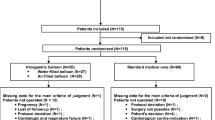Abstract
Aim
To compare the efficacy of laparoscopic sleeve gastrectomy (LSG) and BioEnterics intragastric balloon (BIB®) to lose weight and comorbidities after 12 months of follow-up before a more invasive bariatric procedure.
Methods
From January 2004 to December 2006, 40 patients underwent laparoscopic sleeve gastrectomy (LSG) as a first step in biliopancreatic diversion with duodenal switch. Controls (n = 80) were selected based on charts of patients who, during the same period, underwent BioEnterics intragastric balloon therapy. In both groups we considered: length of procedure, hospital stay, intraoperative or endoscopic complications, postoperative or postendoscopic complications, comorbidities at baseline, after 6 months (time of BIB removal), and after 12 months from baseline, and weight loss parameters [weight in kg, percentage excess weight less (%EWL), body mass index (BMI), and percentage excess BMI loss (%EBL)]. Results are expressed as mean ± standard deviation.
Results
Mortality, intra- and postoperative complications (in LSG group), and intra- and postendoscopic complications (in BIB group) were absent. Mean operative time in the LSG group was 120 ± 40 (range 60–200) min. Mean positioning time for BIB was 15 ± 5 (range 10–25) min. BMI at baseline was 54.1 ± 2.9 (range 45.1–55.9) kg/m2 and 54.8 ± 2.5 (range 45.1–56.2) kg/m2 in BIB and LSG groups, respectively. At 6-month follow-up, mean BMI was 46.2 ± 3.5 and 45.3 ± 5.5 kg/m2 in the BIB and LSG patients, respectively [p = not significant (ns)]. After 12 months BIB patients regained BMI, even if strictly followed with a diet regimen, while LSG patients continued to lose weight. Significant differences between groups were absent for the comorbidities considered.
Conclusions
Laparoscopic sleeve gastrectomy and BioEnterics intragastric balloon are two valid options for producing weight loss as a first-step procedure. LSG has all the related risks of general anesthesia, laparoscopic surgery, and digestive anastomosis, whereas BIB presents a very low rate of minor complications, such as psychological intolerance. For all these reasons, at this time, BIB is considered a better option than LSG as a first-step procedure in the short term (12 months).
Similar content being viewed by others
References
Almogy G, Crookes PF, Anthone GJ (2004) Longitudinal gastrectomy as a treatment for the high risk super-obese patients. Obes Surg 14:492–497
Angrisani L, Lorenzo M, Borrelli V, Giuffré M, Fonderico C, Capece G (2006) Is bariatric surgery necessary after intragastric balloon treatment? Obes Surg 16:1135–1137
Baltasar A, Serra C, Perez N, Bou R, Bengochea M (2006) Re-sleeve gastrectomy. Obes Surg 16:1535–1538
Buchwald M, Williams SE (2004) Obesity surgery worldwide. Obes Surg 14:1157–1164
Busetto L, Segato G, De Luca M et al (2004) Preoperative weight loss by intragastric balloon in super-obese patients treated with laparoscopic gastric banding: a case control study. Obes Surg 14:671–676
Cottam D, Qureshi FG, Mattar SG et al (2006) Laparoscopic sleeve gastrectomy as an initial weight loss procedure for high risk patients with morbid obesity. Surg Endosc 20:859–863
Eisendrath P, Cremer M, Himpens J, Cadiere GB, Le Moine O, Deviere J (2007) Endotherapy including temporary stenting of fistulas of the upper gastrointestinal tract after laparoscopic bariatric surgery. Endoscopy 39:625–630
Eynden FV, Urbain P (2001) Small intestine gastric balloon impact on treated by laparoscopic surgery. Obes Surg 11:646–648
Flum DR, Salem L, Elrod JB et al (2005) Early mortality among Medicare beneficiaries undergoing bariatric surgical procedures. JAMA 294:1903–1908
Genco A, Bruni T, Doldi SB et al (2005) BioEnterics Intragastric Balloon: the Italian experience with 2,515 patients. Obes Surg 15:1161–1164
Genco A, Cipriano M, Bacci V et al (2006) Bioenterics Intragastric Balloon (BIB): a double blind, randomised, controlled, cross-over study. Int J Obes 30:129–133
Gumbs A, Gagner M, Dakin G et al (2007) Sleeve gastrectomy for morbid obesity. Obes Surg 17:562–569
Hamoui N, Anthone GJ, Kaufman HS, Crookes PF (2006) Sleeve gastrectomy in the high-risk patients. Obes Surg 16:1445–1449
Kueper MA, Kramer KM, Kirschniak A et al (2008) Laparoscopic Sleeve Gastrectomy: standardized technique of a potential stand-alone bariatric procedure in morbidly obese patients. World J Surg 32:1462–1465
Langer FB, Bohdjalin A, Felberbauer FX et al (2006) Does gastric dilatation limit the success of sleeve gastrectomy as a sole operation for morbid obesity? Obes Surg 16:166–171
Marceau P, Biron S, Bourque RA et al (1993) Biliopancreatic diversion with a new type of gastrectomy. Obes Surg 3:29–35
Melissas J, Kuokouraki S, Askoxylakis J et al (2007) Sleeve gastrectomy – a restrictive procedure? Obes Surg 17:57–62
Milone L, Strong V, Gagner M (2005) Laparoscopic sleeve gastrectomy is superior to endoscopic intragastric balloon as a first stage procedure for superobese patients (BMI > or = 50). Obes Surg 15:612–617
O’Brien PE, McPhail T, Chaston TB et al (2006) Systematic review of medium-term weight loss after bariatric operations. Obes Surg 16:1032–1040
Regan JP, Inabnet WB, Gagner M (2003) Early experience with two stage laparoscopic Roux-en-Y gastric bypass as an alternative in the super-super obese patient. Obes Surg 13:861–864
Roa PE, Kaidar-Person O, Pinto D et al (2006) Laparoscopic Sleeve Gastrectomy as treatment for morbid obesity: technique ad short-term outcome. Obes Surg 16:1323–1326
Rubin M, Yehoshua RT, Stein M et al (2008) Laparoscopic Sleeve Gastrectomy with minimal morbidity. Early results in 120 morbidly obese patients. Obes Surg
Sallet JA, Marchesini JB, Paiva DS et al (2004) Brazilian multicenter study on the intragastric balloon. Obes Surg 14:991–998
Author information
Authors and Affiliations
Corresponding author
Rights and permissions
About this article
Cite this article
Genco, A., Cipriano, M., Materia, A. et al. Laparoscopic sleeve gastrectomy versus intragastric balloon: a case-control study. Surg Endosc 23, 1849–1853 (2009). https://doi.org/10.1007/s00464-008-0285-2
Received:
Revised:
Accepted:
Published:
Issue Date:
DOI: https://doi.org/10.1007/s00464-008-0285-2




